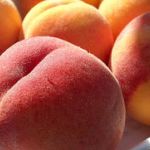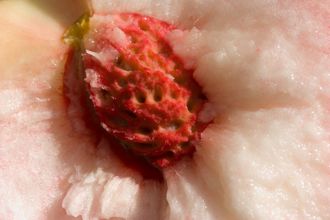
How is a poem like a prayer like a peach? In this season when farmer’s markets (if we’re lucky enough to live by them) and our backyard trees (if we’re luckier still) lavish us with an almost guilt-inducing abundance of textured, fleshy, bursting-with-juicypleasure peaches, what can we glean about this world—and our inner worlds— from their continued bequeathal of life-giving goodness that so richly satisfies both body and soul?
I remember when futurists were predicting not only that we’d be zipping around in our own solo aircraft someday, but that we’d also get all the nutrients we need in a single pill. The first hasn’t yet come to pass and I don’t much care whether it ever does, but the second—wait wait, a world without peaches?
Not my world, not now, not ever.
And to come across the poem From Blossoms by Li-Young Lee, I think it is safe to surmise not his world, either.
This achingly sensual poem exhibits such raw physicality as to almost shed peach juice and little flecks of subtly curled, delicately haired skin on the page. Yet it is not the mere nectar and succulence of peaches that begets such worshipful tonality in a mere 22 lines. Because as powerful as this peach, this object, this thing is, as much as it remains itself in all its glorious and unapologetic essence, every peach, every thing, is about much else as well. (At least under the gaze of a poet.)
***
***
For Lee, the journey of a peach and its prayerful poetry begins with blossoms, quickly involving a boy, a bag, a roadside stand, a sign. All signifiers, all signs themselves. Then boughs, hands, bins, nectar, and the peach’s dusty skin—“dust we eat.” Dust we “take inside,” thus becoming one with the peach and its dust, growing within us our own “orchard,” obliterating, however temporarily, the wall separating inner from outer, subject from object, eater from eaten, the concrete from the abstract. This is peach-eating as Communion, as Sacrament.
Let’s read the poem now before returning to discuss it further.
From Blossoms
By Li-Young Lee
From blossoms comes
this brown paper bag of peaches
we bought from the boy
at the bend in the road where we turned toward
signs painted Peaches.
From laden boughs, from hands,
from sweet fellowship in the bins,
comes nectar at the roadside, succulent
peaches we devour, dusty skin and all,
comes the familiar dust of summer, dust we eat.
O, to take what we love inside,
to carry within us an orchard, to eat
not only the skin, but the shade,
not only the sugar, but the days, to hold
the fruit in our hands, adore it, then bite into
the round jubilance of peach.
There are days we live
as if death were nowhere
in the background; from joy
to joy to joy, from wing to wing,
from blossom to blossom to
impossible blossom, to sweet impossible blossom.
***
From the concrete reality of blossoms, bags and bins in the beginning of the poem, Lee moves us to a figurative “taking inside” of “days” and “shade,” “adoring” the “round jubilance of peach.”
En route, we forsake, for the moment, the ever present shadow of our death, instead flitting from “joy to joy” and the now not concrete, but “impossible” blossom to blossom.
An engaged and attentive human is doing this adoring and celebrating this jubilance. Someone who has come to peaches with a certain openness and expansiveness of spirit and imagination, with attention riveted not only on the thing, the peach before him, but on his inner response, what the peach elicits first in his breathing, his saliva, his loins, and then in his imagination and the language he uses to give that imagination its own fleshly substance of words. All within the even more fleshly structure of a poem.

But it starts with what might be considered, if one is inclined toward religious language, “prayerful” attention. Meaning with one’s whole being—body and mind, sensory apparatus and imagination. Although prayer is popularly considered to be some petitioning of a higher power to bestow its favors upon us and various causes we hold dear—and maybe even to help smote our enemies—among mystics in every tradition, it is not so much asking as attending, not so much hoping as simply observing. This kind of prayer is simple and total, so there is nothing simple about it. It is about complete presence, not some absence we are trying to fill.
***
“I believe that aesthetic presence, aesthetic consciousness, is the wholest or highest form of presence we can achieve,” Lee reflected during a 2000 interview in Santa Fe. “It sacralizes what we observe, or what we attend to. It makes sacred, I shouldn’t say ‘makes sacred,’ it uncovers the sacred nature of our lives. Uncovers the sacred, because you don’t project it, you don’t make it sacred, it is sacred.”
While I would take issue on this last point about sanctity existing as an objective reality unto itself rather than being a function of human consciousness, Lee’s essential point remains. What he’s extolling is the interplay between the things of this world, the attention (prayer) we bring to them, and the imaginative output that artists can then bring forth from that encounter, whether in poetry, painting, photography, sculpture, dance, film or music.
It’s about moments, one moment at a time, prayerfully attended, lovingly absorbed, and worshipfully rendered.
Art, in other words. Resulting from joyous immersion in the glorious gift of a peach.
Amen.
***
“Worshipful” and “prayerful” are as accurate adjectives as any to describe the music of one of my personal favorite pieces, the theme from the movie Cinema Paradiso. (Quite a piece of art in itself.) Enjoy!
***
Visit this blog’s public page on Facebook for regular 1-minute snippets of wisdom and other musings from the world’s great thinkers and artists, accompanied always by lovely photography. https:www.facebook.com/andrew.hidas
Deep appreciation to the photographers!
Elizabeth Haslam, whose photos (except for the books) grace the rotating banner at the top of this page. Some rights reserved under Creative Commons licensing, see more at: https://www.flickr.com/photos/lizhaslam/
Library books photo by Larry Rose, all rights reserved, contact: larry@rosefoto.com
Small feature image of peaches at top of page courtesy of Pat Kight’s Photostream at Flickr, under Creative Commons licensing. See more at: http://www.flickr.com/photos/kightp/
Fleshy peach with exposed pit from stock agency, photographer unknown.
***
“From Blossoms” appears in the volume Rose, copyright © 1986 by Li-Young Lee. Reprinted with permission of BOA Editions Ltd. http://www.boaeditions.org.
A 49-minute interview that includes Lee reading his poetry can be found at http://podcast.lannan.org/2010/06/01/li-young-lee-reading-29-march-2000-video/
















The perfect peach is a fine summer quest, additionally legitimized with this essay, this stunning poem. Have you read, Epitaph for a Peach by Mas Masamoto?
Hadn’t heard of that book, Candi, but read all about it on Amazon just now and it sounds quite worthy of a place on my pile!
I love the way he unites Western and Eastern philosophies. Not many Western writers would include the idea of death in a poem about eating peaches. A nice example of mono no aware; I’m going to have to buy some local strawberries today and eat them for dinner tonight.
Great pics, great poem, great music, great analysis… nice start to my summer day… of course, unbeknownst to me, my daughter (home from college) Zoe zips into the house carrying some peaches just purchased at our local produce stand… couldn’t get her to sit still long enough to read Li-Young Lee’s poem, but the synchronicity (and peaches) was sweet indeed!